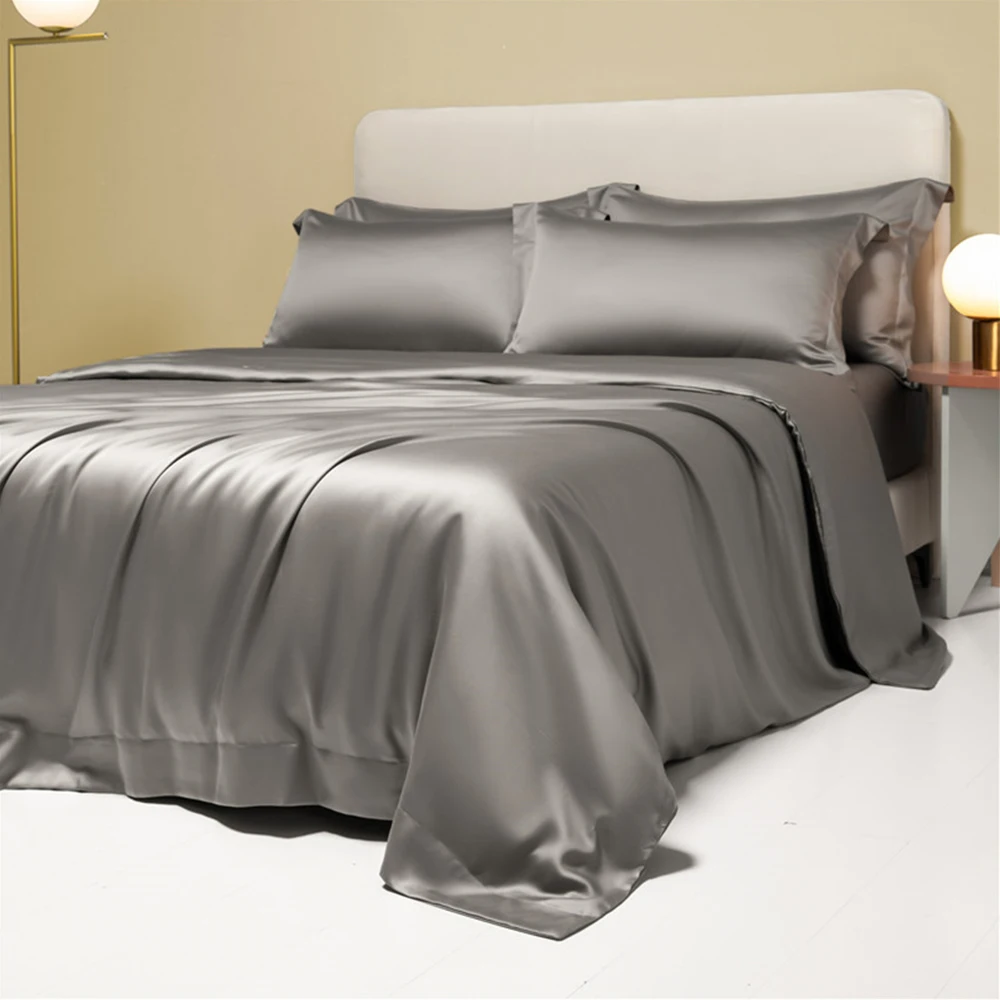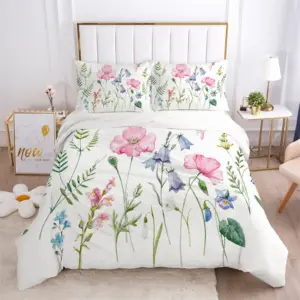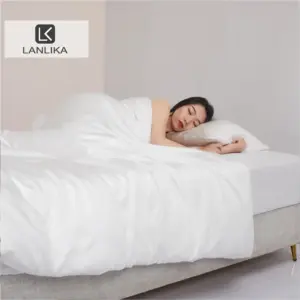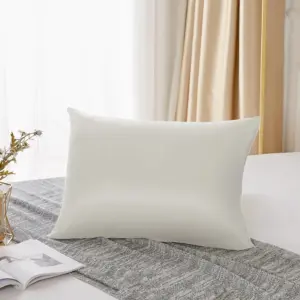Introduction: Understanding the True Measures of Silk Bedding Quality
When shopping for silk bedding, many consumers make a critical mistake – they apply cotton bedding standards to silk products. If you’ve been searching for the “perfect thread count” in silk sheets, you might be using the wrong measuring stick altogether.
In the world of silk bedding, Momme weight, not thread count, serves as the primary indicator of quality. This measurement system exists because silk’s unique material properties require different evaluation standards than cotton or other fabrics.
Textile industry experts consistently emphasize that understanding Momme weight is essential for making informed silk bedding purchases. The misconception about thread count has led many consumers to overlook truly superior silk products while potentially overpaying for inferior options.
Throughout this guide, we’ll explore:
– What Momme weight actually measures and why it matters
– Why thread count is less relevant for silk bedding
– Ideal Momme weights for different silk products
– Additional quality factors that determine silk excellence
The journey to finding exceptional amazing benefits of mulberry silk sheets begins with understanding these fundamental quality metrics.
Understanding Momme Weight: The Essential Measure for Silk Quality
Momme weight (pronounced “moe-mee”) represents the definitive quality measurement for silk fabrics. This traditional Japanese measurement quantifies the weight in pounds of a piece of silk measuring 45 inches wide by 100 yards long.
What is Momme Weight?
Momme (mm) is a unit that measures silk density and weight. Higher Momme numbers indicate that more silk was used per square yard, resulting in a heavier, more substantial fabric.
Unlike arbitrary quality claims, Momme weight provides a tangible, measurable standard. When you hold a 19mm silk sheet next to a 25mm sheet, the difference becomes immediately apparent – the higher Momme fabric feels more substantial, drapes more elegantly, and generally demonstrates superior quality.
This measurement directly correlates with several crucial factors:
- Density: Higher Momme silk contains more silk threads per area
- Durability: Denser silk typically offers greater longevity
- Tactile experience: The weight affects how the fabric feels against your skin
- Opacity: Higher Momme silk tends to be less transparent
Historically, Momme measurement originated in Japan, where silk trade demanded precise quality standards. Today, it remains the gold standard for silk evaluation worldwide, though many consumers remain unaware of its significance.
For a deeper understanding of how this metric affects your sleeping experience, explore our ultimate guide to Momme weight in silk bedding.
Why Thread Count is Less Relevant for Silk Bedding
Thread count – the number of threads woven into one square inch of fabric – works well for evaluating cotton sheets because cotton threads have relatively uniform thickness. However, this metric falls short when applied to silk for several important reasons.
Silk threads are naturally much finer than cotton threads, often varying significantly in diameter. This fundamental difference means that thread count calculations become less reliable indicators of quality. Two silk fabrics with identical thread counts might feel and perform completely differently based on:
- The fineness of the individual silk threads used
- The quality of the raw silk material
- The weaving techniques employed
Consider this: a 300-thread count silk sheet made from premium long-strand Mulberry silk will typically outperform a 600-thread count sheet made from lower-grade silk with shorter fibers. The thread count number alone tells only a partial story.
Marketing campaigns have unfortunately perpetuated the thread count misconception across all bedding types. Many manufacturers emphasize thread count because consumers are familiar with this metric, even when it’s not the most relevant quality indicator.
This doesn’t mean thread count is completely irrelevant for silk – it still provides some information about fabric density. However, Momme weight offers a much more accurate assessment of silk quality, durability, and feel.
For a detailed comparison of these metrics, our thread count vs. silk quality resource provides in-depth analysis.
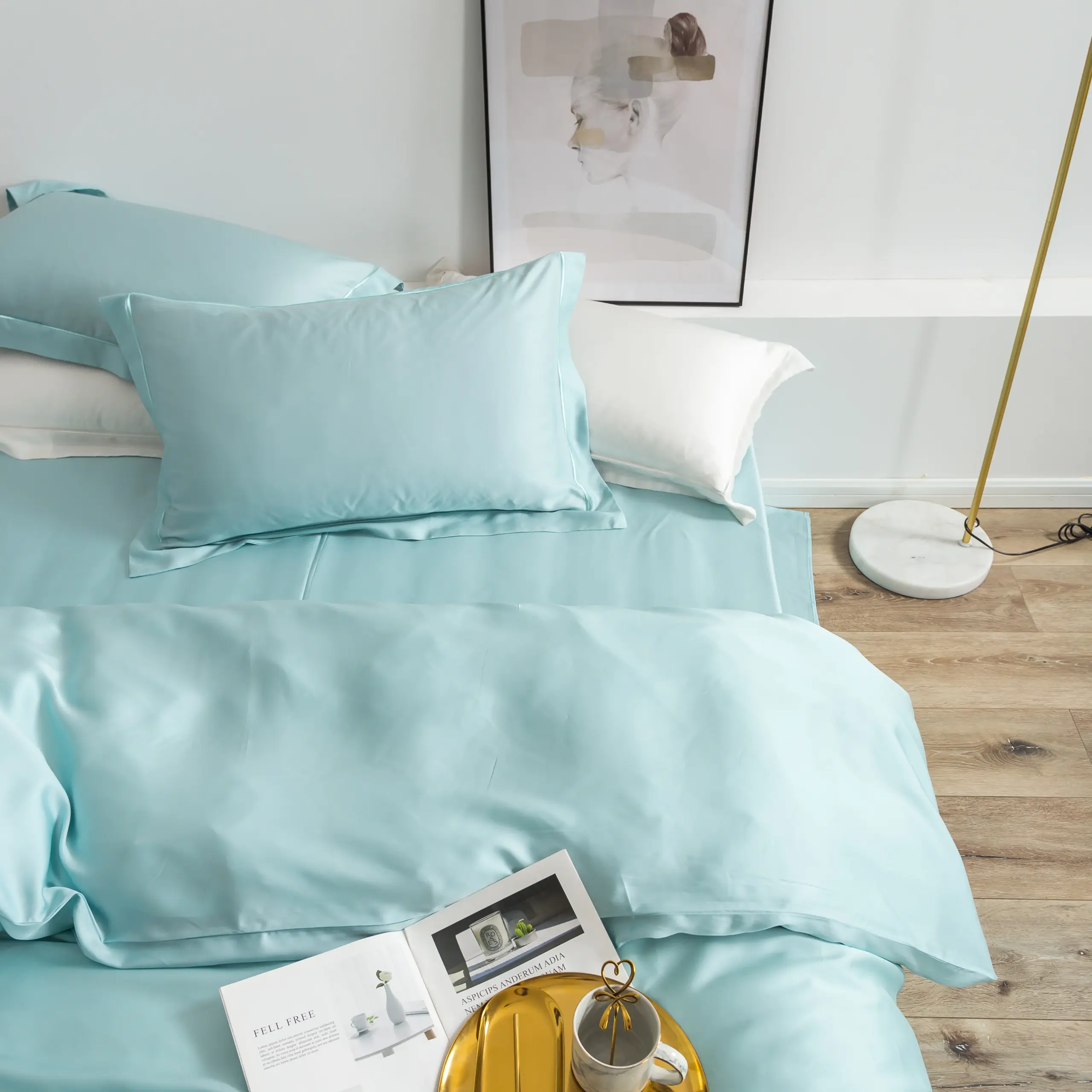
Ideal Momme Weight Ranges for Different Silk Bedding Items
Different silk bedding items perform best at specific Momme weight ranges. Understanding these optimal ranges helps you select bedding that balances luxury, durability, and functionality.
| Silk Bedding Item | Recommended Momme Range | Ideal Momme |
|---|---|---|
| Pillowcases | 19-25mm | 22mm |
| Sheets | 19-25mm | 22-25mm |
| Duvet covers | 19-30mm | 22-25mm |
| Throws/blankets | 16-22mm | 19mm |
The 19mm threshold represents an important quality boundary for silk bedding. Products below this weight typically lack the durability and substantial feel necessary for high-performance bedding. While 16mm silk might be suitable for decorative items or scarves, it generally doesn’t withstand regular use as bedding.
The 22-25mm range offers an optimal balance of benefits:
– Superior durability that withstands regular washing and use
– Luxurious drape that elegantly follows body contours
– Substantial feel that provides comfort without excessive weight
– Enhanced longevity that justifies the premium investment
It’s worth noting that extremely high Momme weights (above 28mm) can sometimes compromise breathability – a key benefit of silk bedding. The ideal range balances density with air circulation, allowing the fabric to regulate temperature effectively.
With proper care, 22mm silk typically maintains its quality for 3-5 years of regular use, while 19mm silk might begin showing wear after 2-3 years. This durability difference highlights why Momme weight matters significantly for long-term satisfaction.
For more specific guidance on selecting the right weight for your needs, our understanding Momme weight guide provides detailed recommendations.
The Role of Thread Count in Silk: A Secondary Quality Indicator
While Momme weight takes precedence when evaluating silk quality, thread count still provides supplementary information worth considering. For silk bedding, a thread count between 400-600 generally indicates high-quality construction when combined with appropriate Momme weight.
The relationship between these metrics is important to understand:
– Higher Momme silk (22-25mm) typically features thread counts in the 500-600 range
– Mid-range Momme silk (19-22mm) often has thread counts between 400-500
– Lower Momme silk (below 19mm) may have thread counts from 300-400
However, the correlation isn’t perfect. A manufacturer could theoretically create a high thread count silk fabric using very fine, lower quality threads that don’t deliver durability or proper feel. This illustrates why thread count alone can be misleading.
Always remember that a high thread count combined with low Momme weight suggests potentially deceptive marketing. Some manufacturers prominently display thread count while obscuring or omitting Momme information precisely because consumers are more familiar with the former metric.
When both measurements are provided, prioritize Momme weight in your decision-making process. The thread count becomes most useful as a secondary confirmation of quality once you’ve established that the Momme weight meets appropriate standards.
For more information about how thread count specifically applies to silk fabrics, our detailed understanding thread count in silk sheets resource provides valuable insights.
Essential Silk Types for Premium Bedding: Mulberry Silk Explained
Not all silk is created equal. Mulberry silk represents the gold standard for bedding applications, accounting for over 90% of the world’s silk production. This premium material comes from silkworms (Bombyx mori) that feed exclusively on mulberry leaves.
What makes Mulberry silk superior for bedding:
– Exceptionally long fibers (up to 1,000-1,500 meters per cocoon)
– Consistent thickness and texture throughout the thread
– Naturally white color that accepts dyes beautifully
– Superior strength and durability
– Smoother texture that reduces friction on skin and hair
By contrast, other silk types like Tussah (wild silk) feature shorter, coarser fibers with less consistent texture. While Tussah has its uses in fashion and decorative applications, it typically doesn’t provide the smooth, luxurious sleep surface that Mulberry silk offers.
It’s crucial to distinguish between genuine silk and synthetic alternatives like polyester satin. While these alternatives might appear similar visually, they lack silk’s natural properties:
– Temperature regulation capability
– Moisture-wicking ability
– Protein structure beneficial for skin and hair
– Natural hypoallergenic qualities
When shopping for silk bedding, always look for products labeled as 100% Mulberry silk. Products described simply as “silk” or “silk blend” may contain lower percentages of actual silk mixed with synthetic fibers, compromising the benefits you’re seeking.
Discover more about what makes mulberry silk special and browse our collection of premium mulberry silk sheets to experience the difference firsthand.
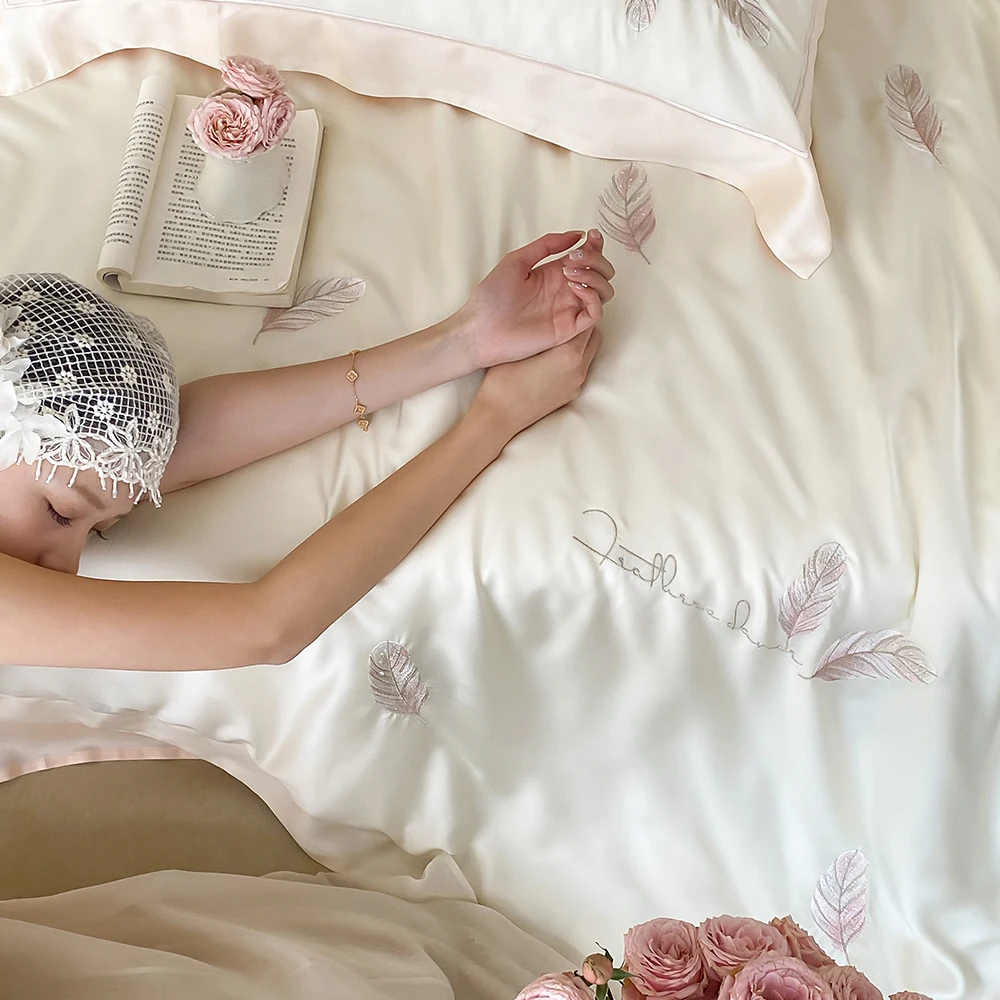
Understanding Silk Grades: From 6A to Lower Grades
Within the world of Mulberry silk, a sophisticated grading system helps distinguish quality levels. This classification system rates silk from grades A through C, with Grade A representing the highest quality. Grade A is further subdivided into categories 1A through 6A, with 6A indicating the absolute pinnacle of silk quality.
The grading criteria include:
– Fiber length: Longer fibers create stronger, smoother fabric with fewer potential weak points
– Uniformity: Consistent fiber diameter and characteristics throughout the fabric
– Cleanliness: Freedom from impurities, slubs, or irregularities
– Color consistency: Even coloration without spots or variations
Grade 6A silk represents the most pristine silk available, featuring exceptionally long, uniform fibers with minimal impurities. This translates to noticeable benefits:
– More lustrous appearance with natural sheen
– Smoother texture against skin
– Enhanced durability through washing cycles
– Superior color retention over time
– Reduced pilling or fiber shedding
Lower grades, while still technically silk, may contain shorter fibers, more irregularities, and less consistent weaving. These differences affect not just appearance but also the performance and longevity of the final product.
When evaluating silk bedding, combining grade information with Momme weight provides the most comprehensive quality assessment. Premium bedding typically features both high grade (5A-6A) and appropriate Momme weight (19-25mm).
For more detailed information about different quality levels and how to identify them, explore our comprehensive guide to the best types of silk bedding.
Important Certifications for Quality Silk Bedding
Beyond physical characteristics, reputable certifications provide additional assurance of silk bedding quality and safety. These third-party verifications confirm manufacturing standards and ensure the absence of harmful substances.
The most significant certification for silk bedding is OEKO-TEX Standard 100, which verifies that:
– The product has been tested for harmful substances
– All components (fabric, thread, dyes) meet strict safety standards
– The production maintains consistent quality control
Additional certifications that may apply to premium silk products include:
– Global Organic Textile Standard (GOTS) for organically produced silk
– BSCI (Business Social Compliance Initiative) for ethical manufacturing
– ISO 9001 for quality management systems
These certifications matter for several important reasons:
– They verify that the silk is free from irritants that might affect sensitive skin
– They confirm the product’s hypoallergenic properties
– They provide independent verification of quality claims
– They ensure consistent manufacturing standards
When shopping for silk bedding, always look for products that display certification logos or provide certification numbers that can be verified. Reputable manufacturers willingly share this information to demonstrate their commitment to quality.
Browse our selection of certified 100% silk sheets to experience bedding that meets the highest standards of quality and safety.
Construction Quality: The Craftsmanship Behind Premium Silk Bedding
Even the finest silk fabric can be diminished by poor construction. Premium silk bedding demonstrates meticulous craftsmanship that enhances both durability and aesthetic appeal.
Key construction elements to evaluate include:
– Seam reinforcement: Double-stitched or French seams prevent fraying and unraveling
– Stitching density: 8-12 stitches per inch indicates quality construction
– Edge finishing: Properly finished edges resist fraying even after multiple washes
– Closures: Envelope closures on pillowcases and hidden zippers on duvet covers
The most common premium silk weave for bedding is Charmeuse, which creates a fabric with a lustrous front and matte back. This weave enhances silk’s natural sheen while maintaining breathability and drape.
Quality construction significantly impacts both appearance and longevity. For instance, properly finished French seams can extend a product’s lifespan by preventing the common edge fraying that often begins the deterioration process. Similarly, thoughtful design elements like envelope closures on pillowcases help prevent slippage during sleep.
When evaluating silk bedding, examine these construction details closely. They often reveal the difference between truly premium products and those that merely appear luxurious at first glance but won’t maintain their quality over time.
For examples of exceptional construction quality, explore our luxury silk bedding sets featuring meticulous craftsmanship in every detail.
How to Choose the Best Silk Bedding: A Practical Guide
Armed with knowledge about what truly determines silk quality, follow these steps to select exceptional silk bedding:
Verify Momme weight first: Look for bedding in the 19-25mm range, with 22mm being an ideal balance of luxury and durability.
Confirm material authenticity: Ensure the product specifies 100% Mulberry silk, not simply “silk” or “silk blend.”
Check silk grade: Seek Grade 6A designation for the highest quality; anything lower than Grade 4A may compromise quality.
Look for certifications: OEKO-TEX Standard 100 certification provides assurance of safety and consistent quality.
Examine construction details: Inspect seam quality, edge finishing, and closure mechanisms.
Consider thread count as supplementary information: For high-quality silk, expect thread counts in the 400-600 range.
Be aware of potential red flags that may indicate inferior quality:
– Missing or vague Momme weight information
– Extremely low pricing compared to market standards
– Generic material descriptions lacking specific silk type
– Absence of recognized certifications
Quality silk bedding represents an investment. While premium silk sheets typically cost more initially, their superior durability and performance provide better long-term value than lower-quality alternatives that require frequent replacement.
For comprehensive guidance on selecting the perfect silk bedding, our complete guide to mulberry silk bed sheets offers additional insights and recommendations.

The Remarkable Benefits of High-Quality Silk Bedding
Investing in premium silk bedding delivers substantial benefits that extend far beyond aesthetics:
Temperature Regulation
High-quality silk naturally regulates temperature within a 3-4°F range, keeping you cool in summer and warm in winter. The protein structure of silk fiber creates micro-pockets that trap air while allowing moisture to escape.
Skin Health Benefits
Silk’s exceptionally smooth surface reduces friction against skin, minimizing compression wrinkles and irritation. Its natural proteins and amino acids (similar to those found in human skin) help maintain moisture balance while you sleep.
Hair Health Advantages
The smooth surface minimizes hair breakage and friction that causes frizz. Higher Momme silk (22-25mm) provides optimal slip for hair preservation.
Hypoallergenic Properties
Premium silk naturally resists dust mites, mold, and mildew. This makes it ideal for allergy sufferers and those with sensitive skin conditions.
Superior Durability
Quality silk bedding, particularly in the 22-25mm range, maintains its integrity through years of proper use. The investment pays dividends through extended product life.
Luxurious Aesthetic and Feel
Beyond practical benefits, silk’s natural luminosity and elegant drape create an undeniable sense of luxury that enhances your bedroom environment.
These benefits become more pronounced with higher quality silk. For instance, 22mm silk typically provides better temperature regulation than 16mm silk due to its more substantial fiber density. Similarly, Grade 6A silk offers smoother texture against skin than lower grades.
For more information about specific benefits, explore our detailed guide about mulberry silk bedding skin benefits or browse our collection of silk pillowcases designed to maximize these advantages.
100% Silk Sheets, Green Silk Sheets, King Size Silk Bedding Set, Mulberry Silk Bedding Sets, Queen Size Silk Bedding Set
Price range: $1,246.21 through $1,615.22 Select options This product has multiple variants. The options may be chosen on the product pageFull Silk Bedding Set, King Size Silk Bedding Set
Price range: $120.99 through $190.49 Select options This product has multiple variants. The options may be chosen on the product pageGrey Silk Sheets, Silk Sheet and Pillowcase Set
Price range: $88.20 through $146.64 Select options This product has multiple variants. The options may be chosen on the product page100% Silk Sheets, King Size Silk Bedding Set, Mulberry Silk Bedding Sets, Queen Size Silk Bedding Set, White Silk Sheets
Price range: $1,000.79 through $1,351.42 Select options This product has multiple variants. The options may be chosen on the product pageKing Size Silk Pillowcases, Mulberry Silk Pillowcases, Queen Size Silk Pillowcases
Price range: $94.96 through $121.56 Select options This product has multiple variants. The options may be chosen on the product pageMulberry Silk Fitted Sheet, Mulberry Silk Sheets
Price range: $486.21 through $944.97 Select options This product has multiple variants. The options may be chosen on the product page
Care Instructions: Maintaining Your Silk Bedding Investment
Proper care significantly extends the lifespan of your silk bedding investment. Follow these guidelines to preserve quality and appearance:
Washing Recommendations:
– Wash every 7-10 days for pillowcases, every 2-3 weeks for sheets
– Hand washing is ideal; machine wash only on delicate cycle if necessary
– Use cold water below 86°F (30°C)
– Select pH-neutral, enzyme-free detergents specifically formulated for silk
Drying Methods:
– Never wring or twist silk when wet
– Roll in a clean towel to remove excess moisture
– Lay flat to dry away from direct sunlight
– Avoid hanging wet silk as it may stretch
Storage Guidelines:
– Store fully dry in breathable cotton bags, never plastic
– Keep away from direct sunlight to prevent fading
– Avoid cedar closets as oils can damage silk fibers
Handling Stains:
– Address spills immediately with lukewarm water
– Never use bleach or harsh stain removers
– Test any cleaning solution on an inconspicuous area first
Higher Momme weight silk (22-25mm) generally demonstrates greater resilience to washing, making it more forgiving of occasional care mistakes. With proper maintenance, premium silk bedding can maintain its quality for 5+ years compared to 2-3 years for lower quality alternatives.
Most Common Silk Bedding Questions Answered
Is silk bedding worth the investment?
Yes, quality silk bedding offers superior longevity, health benefits, and comfort that justify the higher initial cost. Premium silk sheets typically last 3-5 years with proper care, compared to 1-2 years for lower quality alternatives.
Does silk bedding need special care?
While silk requires some special considerations, care isn’t overly complicated. Hand washing or gentle machine washing with appropriate detergents, followed by air drying, maintains quality effectively.
Will silk bedding help with my allergies?
Yes, silk naturally resists dust mites, mold, and mildew – common allergen triggers. Its protein structure also minimizes irritation for those with sensitive skin.
Is silk bedding suitable for all seasons?
Absolutely. Silk’s natural temperature regulation properties make it ideal year-round. It helps keep you cool in summer and warm in winter by efficiently managing moisture and maintaining a comfortable microclimate.
How can I tell if silk is authentic?
Authentic silk feels cool to the touch initially but warms quickly. It has a subtle sheen rather than artificial shininess, and when rubbed between fingers, produces a distinctive rustling sound called “scroop.”
For more detailed answers to common questions, visit our comprehensive guide to mulberry silk sheets.
Making an Informed Silk Bedding Purchase: Final Considerations
When investing in silk bedding, remember these critical quality indicators:
- Momme weight stands as the primary quality metric, with 19-25mm representing the ideal range for bedding
- 100% Mulberry silk provides superior benefits compared to other silk types or blends
- Grade 6A classification ensures the highest quality silk fibers and processing
- Construction quality significantly impacts both appearance and longevity
- Thread count serves as a supplementary metric, ideally in the 400-600 range
While quality silk bedding represents a greater initial investment than conventional bedding, the extended lifespan and exceptional benefits provide superior value over time. Quality silk products maintain their integrity through hundreds of nights of use when properly cared for.
Most importantly, the unparalleled sleep experience offered by premium silk – combining temperature regulation, skin and hair benefits, and luxurious comfort – creates a sanctuary for rest that simply cannot be matched by synthetic alternatives.
For those seeking to transform their sleep environment, understanding these quality metrics enables confident decision-making when selecting silk bedding that will provide years of exceptional comfort and performance.
For more detailed comparison of these crucial quality metrics, our Momme vs. thread count silk guide provides comprehensive information to support your purchase decision.

